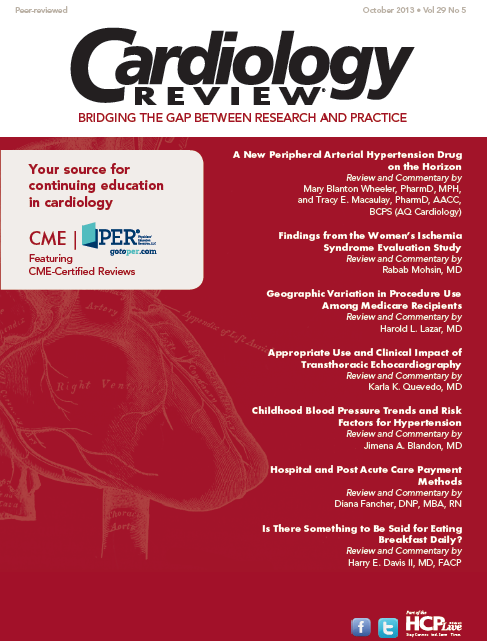Hospital and Post Acute Care Payment Methods
Diana Fancher, DNP, MBA, RN, says replacing the fee-for-service model with bundled payments has its own set of problems.

Diana Fancher, DNP, MBA, RN
Review

Feder J. Bundle with care—rethinking Medicare incentives for post-acute care services. N Engl J Med. 2013;5:400-401.
Health policy has been a target and topic for debate, accelerating in controversy following the enactment of the Patient Care and Affordable Care Act (ACA) in March 2010.1 One topic most health policy experts agree on is the inefficiencies inherent in the fee-for-service payment methodology. Writing in The New England Journal of Medicine’s “Perspective” section, Judith Feder, PhD, Professor of Public Policy at the Public Policy Institute of Georgetown University and an Institute Fellow at the Health Policy Center of the Urban Institute in Washington, DC, states that this method of payment, which incentivizes increases in service volume without recognition of the health benefit—or lack thereof—has become “practically indefensible.” However, she notes, replacing payments for each encounter or service with bundled payments for a set of services does not simply promote efficiency; conversely, it could potentially promote skimping on care or avoidance by providers of complex, costly patients.
Supported by the 2014 presidential budget, a large-scale demonstration of bundled payments for hospital and post acute services, skilled nursing facilities (SNFs), and home health agencies (HHAs) was recently announced by The Center for Medicare and Medicaid Innovation of the Centers for Medicare & Medicaid Services (CMS). Feder fears this demonstration project will result in a sacrifice in quality and access to care in pursuit of efficiency, and she proposes a system in which savings and risk are shared—“a hybrid of a fee-for-service system and one providing rewards for spending reductions” to achieve a better balance of cost, quality, and access than a system of single bundled payments—at least until we are able to measure patient care needs and outcomes in a robust way.
Feder states that Medicare programs already have experience with bundled payments for sets of services; for example, inpatient services are “stays” and SNF services are bundled into “days.” She says that it is “old news” that bundles’ powerful rewards for reducing costs create a trade-off between efficiency and selection, and she maintains that behavior favoring service to low-cost patients over high-cost patients persists.2 Feder further speculates that patients are at risk for selection and skimping on post acute care, an observation she bases on experience with current prospective payment incentives for providers to keep costs low as well as the “presence of extremely high and varied profits in a service area devoid of standards for high-quality care.” In 2010, Feder states, SNFs and HHAs earned profits of 19% on average, and the top quarter earned in excess of 27%.2
Two factors other than efficiency may explain the high margins. First, patient classification systems are not precise enough to prevent positive effects from selecting patients based on profitability potential. In addition, based on this selection of patients with lesser needs and a lower number of required visits, high profit margins would be reflected.
In her review, Feder suggests a hybrid system of payment be implemented, which would balance efficiency and appropriate care. In this payment methodology, both savings and risk are shared. Providers would receive a share of any profits. In addition, Medicare would pay a share of any costs that exceeded the amount of any prospective payments. In reducing profits, this savings/risk approach would reduce providers’ incentive to maximize efficiency. While it would increase administrative burdens, Feder asserts that reducing the gain for providing services to those patients who do not need care will offset these increased costs. Shared risk-and-savings approaches, she says, would produce a competitive market environment. Feder states this may be the best strategy for promoting Medicare’s efficiency, without compromising quality, and she urges policy makers to be mindful of the risks as well as the benefits of choices made during policy formation.
CommentaryDon’t Further Cripple the Post- Acute Arena of Care
The ACA’s goals include improving quality and decreasing the cost of health care, improving coordination of care, and increasing access to healthcare. Effective January 2013, the law requires the initiation of a national pilot program that includes the bundling of payments. The different health care providers, including post acute care, treating a patient for the same or related condition are paid a “bundled” payment for the care during the episode, rather than being paid for each individual test or procedure. Bundling payments is a method in which payments to health care providers are related to the predetermined expected costs of a grouping of health services. Cost has been noted to decrease, with small effects related to quality.3
Currently, variations of bundled payments are beginning pilot programs. There are many factors influencing variations in post acute care, which could influence both quality and cost. The hybrid payment suggested by Feder does not account for the complexities of patients, demographics, and patients’ ability to pay. Post acute care is a vital part of the health care continuum, although reimbursement for these services has been consistently cut over time.
Four models of care will be tested during the pilot, 2 of which will be related to post acute care. Model 2 includes the inpatient stay, and all related services while in the hospital, and can last 30, 60, or 90 days. In Model 3, the episode of care will be triggered by the acute hospital stay and will begin at initiation of post acute care services with a participating SNF, rehabilitation hospital, or home health agency for up to 30, 60, or 90 days.4 These models assume mutual collaboration, and no gaming of the system for success to achieve positive outcomes for the patients.
Feder’s commentary advocates a hybrid version of the proposed changes in payment models that applies a shared-risk-and-savings approach. The premise for this is that the post acute providers would earn a share of profits, but would bear the larger share of the costs, according to Feder, who cites a graph dated 2007- 2009, titled Variation in the Total Per Capita Medicare Spending Explained by Categories of the Post-Acute Spending and All Other Spending, which explains 40% of the geographic variation in Medicare spending per beneficiary. Feder’s use of 2010 figures for SNFs and HHA profits doesn’t take into account tremendous change and cuts in spending related to home health services since 2009.
The large variation in profits could be related to many factors, including efficiency, quality of care, demographics, patient selection, and access to care, to name a few variables. In areas of highly insured populations, it would be logical to see a higher use of post acute care, as opposed to areas with large populations of uninsured patients, where patients are often sent home with instructions related to care and a high probability of readmission, without post acute care in the appropriate setting. According to a report by the Commonwealth Fund,5 a key factor in reducing readmission rates has been found to be a focus on clinical excellence and patient safety. This would include a fully vertically integrated health system, which would include the use of post acute care.5
HHAs have struggled over the past decade, as payment methodologies have changed, and an increase in reimbursement has not been seen in years. A recent news conference featuring the National Association for Home Care & Hospice (NAHC), Visiting Nurses Association (VNA), and the Partnership for Quality Home Care (PQHH), decried the impact of cuts to post acute care. Since 2009, Medicare home health payments have been cut by $72.5 billion, with the current prospect of approximately another $22 billion. A recent analysis of Medicare claims suggests that clinically appropriate use of skilled home care can reduce costs, improve chronic disease management, and strengthen care coordination.6
The literature available today demonstrates the need to collaborate and integrate care in order to optimize patient outcomes. This strengthens the argument for bundling payments and the need to incorporate well-planned care transitions for patients moving from the acute care setting to post acute. There will be significant hurdles and challenges as the changing methods of payments are rolled out. It is my belief that further crippling the post acute arena of care only serves to weaken an already fragile link in the care of patients. The hybrid, shared-risk plan proposed by Feder would only serve to further dismantle this vital portion of care in the continuum needed to drive better outcomes, more robust chronic disease management, and decreased readmissions.
References
1. The 2010 Patient Protection and Affordable Care Act [HR3590]. http://www.gpo.gov/fdsys/pkg/PLAW-111PUBLI1148/PDF/paw-111publ1148.pdf.
2. Feder J. Bundle with care—rethinking Medicare incentives for postacute care services. N Engl J Med. 2013:400-401.
3. Agency for Healthcare Research and Quality. Bundled payment: effects on health care spending and quality. http://www.ahrq.gov/research/ findings/evidence-based-reports/gapbundtp.html. Accessed September 26, 2013.
4. Centers for Medicare & Medicaid Services. Bundled payments for care improvement (BPCI) initiative: general information. http://innovation. cms.gov/initiatives/bundled-payments. Accessed September 26, 2013.
5. The Commonwealth Fund. Reducing hospital readmissions: lessons from top-performing hospitals: synthesis report. April 6, 2011. http:// www.commonwealthfund.org/Publications/Case-Studies/2011/Apr/Reducing-Hospital-Readmissions.aspx. Accessed September 26, 2013.
6. National Association for Home Care and Hospice. Home health leaders: Medicare proposed rule could result in nearly $100 billion in total cuts to home health benefit. http://www.nahc.org/mobile/NAHCReport/ nr130828_1/. Published August 29, 2013.
About the Author
Diana Fancher, DNP, MBA, RN, is Chief Nursing Officer at the University Medical Center of El Paso in El Paso, TX, where she administers, directs, and coordinates patient care services and operations in this 394-bed acute care facility/Level 1 Trauma Center/academic teaching hospital. Dr. Fancher has over 19 years of experience in health care and is a member of the hospital’s senior executive team in planning, policy formation, strategic decisions, and implementation, and is directly responsible for an $85 million operational budget and $2 million capital budget.
